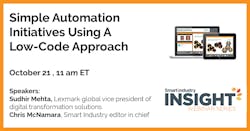INSIGHT webinar preview: Learning simple, low-code automation
On October 21, we connect with Sudhir Mehta, Lexmark’s global vice president of digital transformation solutions, for the INSIGHT webinar “Simple Automation Initiatives Using A Low-Code Approach.” Today we preview that presentation with a short discussion about making automation simple. Take a look…
Smart Industry: Are automation initiatives as complicated as some fear them to be?
Sudhir: Automation initiatives can sometimes be perceived to be overly complex. It may be due to burdensome processes, technology components involved, and time-intensive change-management required to orchestrate these automations. Many times, automation initiatives do not focus on simplifying the business processes and just try to automate what is already in place. The technology components can involve a lot of coding that requires a level of expertise not available in the enterprise. If the previous two steps are not handled correctly, then an enterprise needs to have a rigorous change-management system in place to re-train, educate and inform employees. As a result, automation projects can be expensive, time-consuming and many enterprises may stop them altogether.
Smart Industry: What are one or two of the key components of the low-code approach?
Sudhir: With a low-code approach, the primary focus is in developing the business rules, capturing the business logic and then executing. While business rules themselves can be developed and captured in a variety of ways, the low-code approach strives to provide a user an easy way to capture the business logic in an efficient user interface, apply it against a set of data, and then take meaningful actions based on the application of the business logic.
Smart Industry: What is the difference in perception between an IoT platform as an execution method rather than a piece of technology?
Sudhir: The perception is skewed toward the platform being a piece of technology. This is largely because the first and second generation of platforms were focused on connecting devices to the platform, performing device-management and collecting telemetry data from sensors. While essential, these are technology components that can sometimes be seen divorced from business value and use cases that require a different approach in developing an IoT platform. This is where the right platform can provide next-generation capabilities with components that deliver business value and outcomes to an enterprise.
